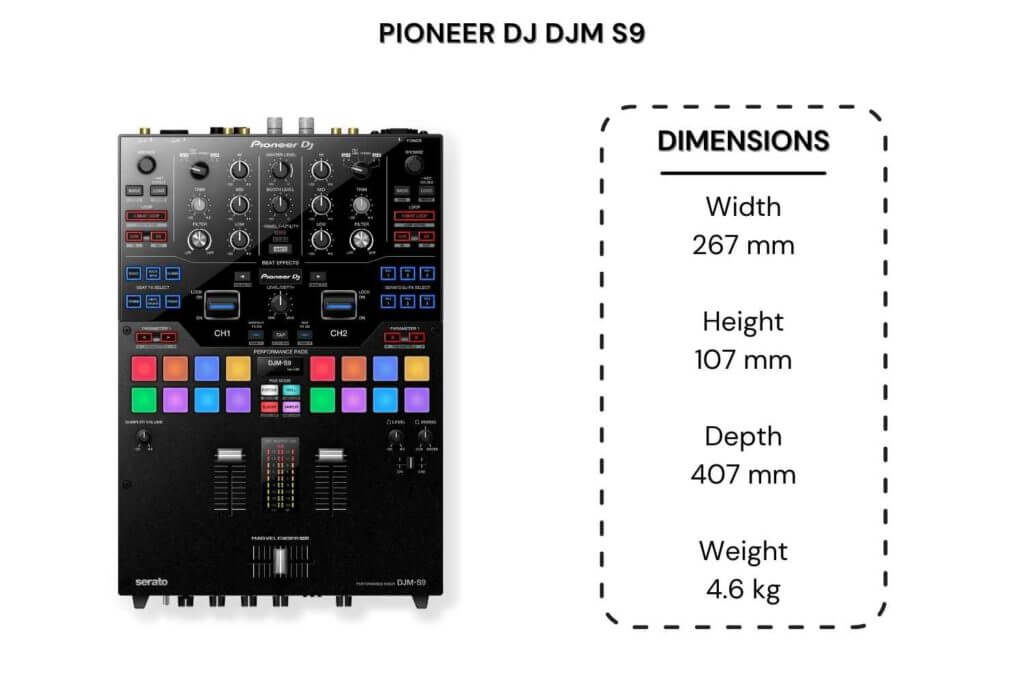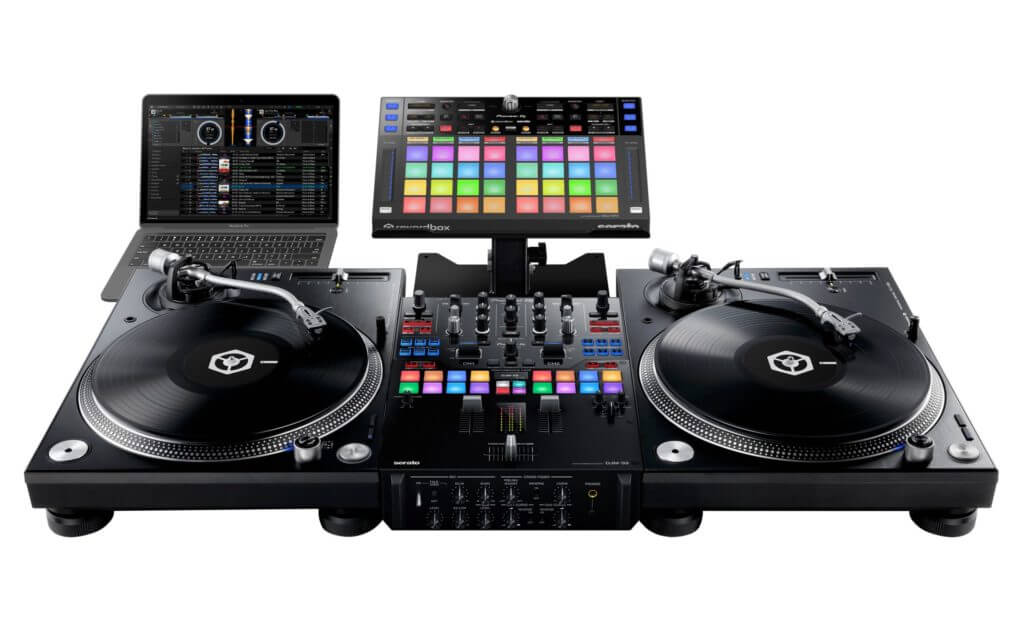One of Pioneer DJ’s most recognized and best battle mixer units, the Pioneer DJ DJM-S9, is a top-shelf Midi-enabled mixer that has been seen as a great option for many scratch DJs since its initial launch way back in 2015.
The controller has been universally loved by turntablists that were interested in more than just scratching. This impressive DJ mixer unit has been widely heralded as one of the best battle mixers of its time. However, how does it stack up today? Is the DJM-S9 still up there as a standout best battle mixer?
Well, that’s what we’re here to find out.
Is It Any Good?
If you know what you’re looking for, you can find a lot of enjoyment here with the DJM-S9 and what it has to offer. On its own, even today, this mixer is a great option for DJ battles, scratch DJs, or turntablists, and something everyone should have a chance to play with at least once in their career.
Is it still that truly amazing piece of work that it was nearly a decade ago, or have there been enough other units that have come out to make this once-great device seem ultimately obsolete?
Well, keep reading this review to find out.
First Impressions
Immediately when taken out of the box, the first thing you’re going to notice about the DJM-S9 is that it’s almost shockingly lightweight. I’m not saying it’s so light you’ll forget you’re holding it or anything, but it is certainly a lot lighter than you’d initially think.
The mixer is more comparable with that of a controller than anything, which does have its pros and its cons.
Much of its lightness can be attributed to the fact that its bottom is made primarily of plastic rather than metal. And, while it doesn’t feel necessarily “cheap” by any means, there is something to be said about a metal build strictly in terms of the overall construction of a device.

Connection Layout
In terms of its different connection ports, the Pioneer DJ S9 carries two pairs of Master output points; one for XLR and the other for RCA.
In addition, there is also a pair of 1/4th-inch Booth ports as well as an input combo port for XLR, which can be used for connecting a mic.
The S9 also has an RCA Aux port and two pairs of phono/line ports which can be used as either a way to hook up your turntable or CDJ.
One thing to remember is that this mixer is a two-channel mixer and a two-channel mixer only.
That means while you’ve got tons of different inputs and connection options available (particularly when it comes to turntable and CDJ options) you’re only going to have access to two of them at any one point in time.
The unit carries a pair of grounding posts that are used for connecting the earthing aspects of your turntables. This is an appreciated addition, as most battle mixers have only a single one that you can crowd the ground to.
This isn’t an essential option, but it’s certainly nice to have.
Controller Deck Layout
When it comes to what the deck has available to it, the DJM-S9’s volume faders are quite slick.
This is in addition to the Magvel Fader Pro crossfader, which can have its looseness adequately tweaked to be looser or tighter when used, based on your personal preferences.
Personally, I’m more of a fan of crossfaders that have a bit of resistance to them. I’m naturally a bit bigger, and loose crossfaders generally mean I have to really hold back when I want to get that perfect transition set up.
So being able to play with it at my own pace is certainly a refreshing opportunity.
Ultimately, however, one of the biggest issues is just how “much” is thrown on here. If you were to boil everything down to one simple thing, it would be that this battle mixer is “busy”.
When you consider that one of the things that makes a mixer so compelling is that it’s got as little going for it as possible (pretty much just a couple of channels and a smooth crossfader) the act that this has as much going for it is pretty much a blessing as well as a curse.
The top deals with much of the EQ options as well as the different loop, browse, and output options as well as matrix switching. Meanwhile, the middle area deals primarily with paddle switches, performance pads, and the DJ FX selectors.
Finally, the bottom area deals with the different volume control options as well as the above-mentioned Magvel Fader Pro crossfader.
Again, while much of this is very useful when brought out to play with, it can easily be overwhelming and seem visually busy, especially for those getting started as DJs.

Features and Effects
So we’ve had a chance to check out the different options for the mixer from a physical standpoint. Now, it is worth seeing what is offered to the mixer by way of its different effects and features.
The EQ Section
As the mixer features different EQ knobs for the mids, highs, and low-end frequencies – as well as the trim pots – all of these areas are sufficiently quite nice, each having a quality rubber material that feels great to the touch.
It also has filters along either channel, which makes the mixer very useful for dual mixing. The one issue is that the cap is made from a hard plastic material rather than the same rubber used for the rest of the knobs. It’s not a huge issue or anything, but it is certainly noticeable when you see what is and what isn’t covered.
Switching Matrix
Sitting around the top of the unit itself, this knob is used for switching along with the different input sources for either channel. The DJM-S9 has two USB socket options that can be used for plugging in two separate laptops.
You can also use this to decide whether you want to use one of your channels to control either laptop via the switching matrix feature.
You also have the option of choosing whether to run a line through or the phono input through your channels.
This decides whether you would want to play from your CDJs themselves or by spinning actual vinyl records through your DJ set.
This product has been discontinued. However, used examples may be available at Reverb.com
Browse & Looping Control Options
The S9 has a browse knob option for each of its channels, as well as a load and a navigation button that is available for your song library.
The unit also comes with a “4 Beat Loop” button that will automatically set a one-bar loop through the Serato DJ software (one bar is the equivalent of four beats).
The looping feature also has buttons that are used to either double or halve their overall number, as well as the ability to manually loop in and loop out certain points by using the “Shift” button.
This is found neatly hidden away under the Booth output knob and is surrounded by other EQ control options.
It’s not the most ideally placed feature, but, in terms of its overall performance, it works well enough.
FX Section
The FX section is probably some of the most complex and complicated stuff I’ve seen in a long while. Seriously.
There are two bank switches – one on the left and right side – that do some pretty different things based on the side.
The right side of the unit has the Serato DJ FX Select option, which offers six different Serato DJ effects to choose from during a performance.
Meanwhile, the left side has the Beat FX Select option. This option works by letting you choose from six more different onboard effects, in this case, they are Pioneer DJ effects. It’s a pretty neat function if a bit intimidating when you first start to play with it.
By pressing the Beat FX button of your choice, you can pull up the S9’s central display, which has two separate parameter buttons that individually let you modify a particular Beat FX setting or effect.
There is also a knob for the Beat FX unit’s level/depth, controlling exactly what amount of the affected audio is played out of the Master output section.

Paddles
On the other side of things are the effect paddles.
These are easily one of the battle mixer unit’s coolest features. When pulled down, the effect paddles act as momentary switches, turning a chosen effect on.
This means that, when let go, the effect “snaps back” to its original position, going off in the process. Pushing the paddle up locks the effect in place and keeps it on indefinitely.
This is a great option for turntablists, as they are able to perform some cool quick FX-in and FX-out cuts for that added bit of flair when performing.
Performance Pads
The mixer has a very good performance pad setup overall that feels great and is very responsive.
Seen on the unit are eight RGB backlit pads that have up to four different modes you can access via the performance pads: Hot Cues, Roll, Slicer, and Sampler.
- Hot Cue allows you to set, trigger, and delete different hot cues while in the Serato DJ software
- Roll lets you create loop rolls of varying lengths with the tracks
- Slicer allows you to perform the “Slicer” function as described in the Serato DJ software. This lets you play out a “slice” of music while using the respective performance pads
- Sampler engages the SP-6 Serato DJ sampler player system,
On their face, there seems to be a lot to love about these performance pads and very little to hate.
They’re incredibly responsive while also being stiff enough that you can perform hot cue point juggling and drum fills, something the modern-day battle DJ is going to be a huge fan of.
On the other hand, however, there are many times when they can seem a bit “too” responsive. And, when combined with the fact that they’re actually a fair bit smaller than what you’d see on most controllers (like the DDJ-SX2 or the DDJ-RZ), it’s “very” easy to find yourself accidentally hitting one of the other pad options while in performance where you’re not quite as focused on being careful as you otherwise would be.
Either way, it’s not necessarily the end of the world, but rather just a very frustrating (and possibly embarrassing) issue that can pop up if you’re not paying attention.
Mixer Section
The unit comes with two different volume faders, each of which coming also with adjustable curves and a reverse switch.
In addition, the mixer for the S9 also has the Magvel Fader Pro crossfader.
This feature is also given a curved adjustment and reverse switch while also having the unique knob known as the “Feeling Adjust” knob. This unique feature allows the Magvel Fader Pro to be set at being very loose or very tight.
While it may seem like something relatively small for people that aren’t scratchers or performing DJ battles, the reality is that this is kind of a game-changer that could potentially sell the DJM-S9 by itself.
As a super customizable Magvel Fader pro crossfader option, it still is something of a big draw even now nearly a decade later.
I may not be a master when it comes to scratching and mixing, but even I can acknowledge and understand the gravity of having super buttery smooth faders that can do quick cuts super clean.
On the opposite side of the mixer are the volume controls for the SP-6 Sample Player.
There is also controls there for the headphone level, cue/master mix knob, as well as the “cue monitor” fader. All of these control options allow you to better blend the two channels in a deeper way while using your headphones.
Lastly, there’s the mic section. This is set at the unit’s front panel and is fairly extensively set. It’s placed with on and off options for the microphone as well as a talk-over switch, a volume knob, and a two-band EQ and echo effect knob.
There is also an Aux level knob that can be used to adjust the sound input of a line-level device that you may have connected to the back of the unit, like a tablet or smartphone device.

Our Final Verdict
When it comes to scratch mixers on the market, there are obviously more impressive ones today than there were back in 2015. For example, the more recently released DJM-S7 and DJM-S11 are both awesome updates to this battle mixer.
There is clear evidence that, while it was certainly a killer in 2015, many things that seemed revolutionary at its time aren’t so revolutionary today. Still, just because its age shows a little doesn’t mean it’s by any means a “bad” mixer. Quite the opposite.
The reality is that there is a lot of fun to be had with the DJM-S9, from the Magvel Fader Pro crossfader to the performance pads, to the various DJ FX offered.
Still, it’s important to answer the question, “Is the Pioneer DJM-S9 Mixer worth your time?“
I would say, for turntablists, mixers, and scratchers, it’s an excellent option to have.
No, it’s not going to be the thing that changes a controller head’s mind or makes someone who’s not been a fan of mixers suddenly jump ship.
This product has been discontinued. However, used examples may be available at Reverb.com





